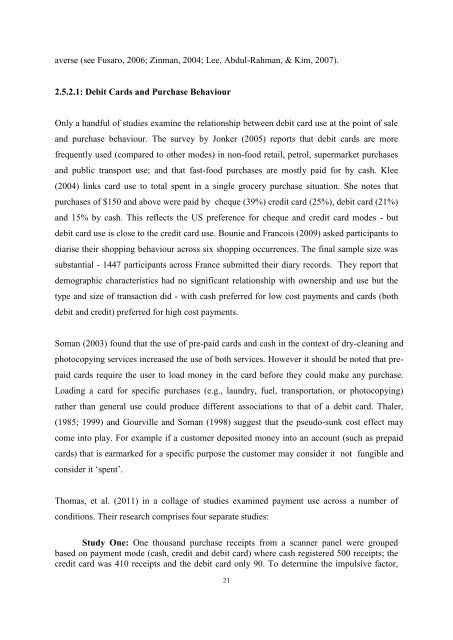Cash or Card: Consumer Perceptions of Payment Modes - Scholarly ...
Cash or Card: Consumer Perceptions of Payment Modes - Scholarly ...
Cash or Card: Consumer Perceptions of Payment Modes - Scholarly ...
You also want an ePaper? Increase the reach of your titles
YUMPU automatically turns print PDFs into web optimized ePapers that Google loves.
averse (see Fusaro, 2006; Zinman, 2004; Lee, Abdul-Rahman, & Kim, 2007).<br />
2.5.2.1: Debit <strong>Card</strong>s and Purchase Behaviour<br />
Only a handful <strong>of</strong> studies examine the relationship between debit card use at the point <strong>of</strong> sale<br />
and purchase behaviour. The survey by Jonker (2005) rep<strong>or</strong>ts that debit cards are m<strong>or</strong>e<br />
frequently used (compared to other modes) in non-food retail, petrol, supermarket purchases<br />
and public transp<strong>or</strong>t use; and that fast-food purchases are mostly paid f<strong>or</strong> by cash. Klee<br />
(2004) links card use to total spent in a single grocery purchase situation. She notes that<br />
purchases <strong>of</strong> $150 and above were paid by cheque (39%) credit card (25%), debit card (21%)<br />
and 15% by cash. This reflects the US preference f<strong>or</strong> cheque and credit card modes - but<br />
debit card use is close to the credit card use. Bounie and Francois (2009) asked participants to<br />
diarise their shopping behaviour across six shopping occurrences. The final sample size was<br />
substantial - 1447 participants across France submitted their diary rec<strong>or</strong>ds. They rep<strong>or</strong>t that<br />
demographic characteristics had no significant relationship with ownership and use but the<br />
type and size <strong>of</strong> transaction did - with cash preferred f<strong>or</strong> low cost payments and cards (both<br />
debit and credit) preferred f<strong>or</strong> high cost payments.<br />
Soman (2003) found that the use <strong>of</strong> pre-paid cards and cash in the context <strong>of</strong> dry-cleaning and<br />
photocopying services increased the use <strong>of</strong> both services. However it should be noted that pre-<br />
paid cards require the user to load money in the card bef<strong>or</strong>e they could make any purchase.<br />
Loading a card f<strong>or</strong> specific purchases (e.g., laundry, fuel, transp<strong>or</strong>tation, <strong>or</strong> photocopying)<br />
rather than general use could produce different associations to that <strong>of</strong> a debit card. Thaler,<br />
(1985; 1999) and Gourville and Soman (1998) suggest that the pseudo-sunk cost effect may<br />
come into play. F<strong>or</strong> example if a customer deposited money into an account (such as prepaid<br />
cards) that is earmarked f<strong>or</strong> a specific purpose the customer may consider it not fungible and<br />
consider it ‘spent’.<br />
Thomas, et al. (2011) in a collage <strong>of</strong> studies examined payment use across a number <strong>of</strong><br />
conditions. Their research comprises four separate studies:<br />
Study One: One thousand purchase receipts from a scanner panel were grouped<br />
based on payment mode (cash, credit and debit card) where cash registered 500 receipts; the<br />
credit card was 410 receipts and the debit card only 90. To determine the impulsive fact<strong>or</strong>,<br />
21

















